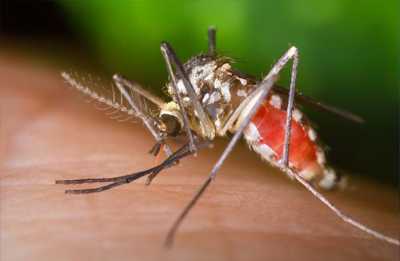AMD Projects: Sequencing Bunyaviruses
Molecular characterization, detection and discovery of bunyaviruses transmitted by arthropods (e.g., mosquitoes, ticks, sand flies)

Most bunyaviruses are transmitted by mosquitoes, ticks, or sand flies. The Ochlerotatus triseriatus mosquito pictured here carries a type of bunyavirus that is associated with pediatric encephalitis in the United States.
Bunyaviridae is a large and diverse family of viruses. Most are transmitted by mosquitoes, ticks, and sand flies. Bunyaviruses that are known to cause human disease include the viruses that cause Rift Valley fever, Crimean-Congo hemorrhagic fever , and hantavirus pulmonary syndrome . Recently, newly described bunyaviruses have emerged as causes of severe human illnesses in China, the United States and other countries.
Scientists know very little about most bunyaviruses. They believe that the public health impact of these viruses has been grossly underestimated because of this lack of knowledge. To address this, CDC has generated gene sequence data and improved detection methods for 47 bunyaviruses. Nonetheless, most bunyaviruses remain poorly described and undetectable at this time.
To help solve this problem, CDC is using genomic sequencing to analyze its bunyavirus specimens. CDC scientists will use these data to create new tests to diagnose bunyavirus infections. This will help researchers worldwide to improve their ability to detect these viruses and determine more precisely the impact of bunyaviruses on public health.
2017 Project Update
Since this project began, AMD methods have been used to detect and identify numerous emerging arthropod-borne viruses (arboviruses) as part of global collaborations. Internationally, this work includes the first description of the mosquito-borne Batai virus in Italy, as well as the identification of sandfly fever Sicilian virus as the cause of an outbreak of febrile illness in Ethiopia. In 2016, work performed through this project helped inform vector control and vaccination efforts for a Yellow Fever outbreak in Angola, which are curbing further spread of this virus.
In the United States, researchers applied AMD methods for the identification of an emergent, lethal genotype of mosquito-borne La Crosse virus, which can cause deadly encephalitis in children; the primary identification of the tick-associated Heartland virus as a cause of fatal human illness in the United States; and the discovery of tick-associated Bourbon virus linked to a patient’s death in Kansas. In addition, research efforts have included the comprehensive genetic description of multiple, emergent chikungunya and Zika virus strains in the Western Hemisphere. Using genetic data generated by AMD methods, researchers have developed, optimized, and distributed diagnostic assays for the detection of numerous emerging pathogens by other laboratories worldwide. Collectively, these efforts continue to guide the control and prevention of arboviral diseases in the most effective and timely way possible.
- Page last reviewed: March 22, 2016
- Page last updated: March 22, 2016
- Content source:


 ShareCompartir
ShareCompartir